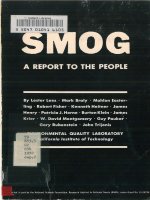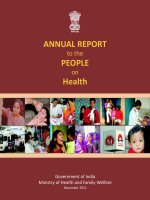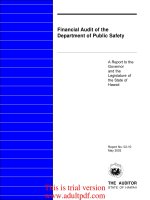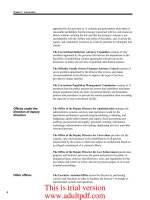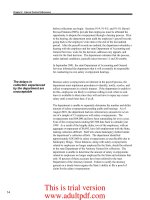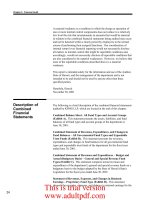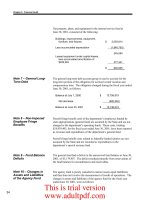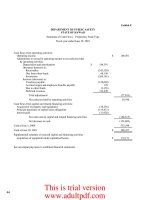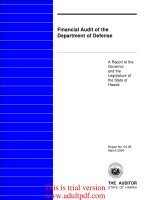Smog - A REPORT TO THE PEOPLE Episode 4 pot
Bạn đang xem bản rút gọn của tài liệu. Xem và tải ngay bản đầy đủ của tài liệu tại đây (687.44 KB, 17 trang )
the differences in
emISSions
between
EQL
Strategy #1 and the present
strategy (Figures 3, 4 and 10).
Conversions have begun for car and truck fleets, which typically burn
larser amounts
of
fuel
than
th~
aY~rag~
Y~hiClcs
l\ml
ilrC
illrci\uy
being
attracted by the economic benefits
of
gaseous fuels. Since fleet vehicles burn
more gasoline per vehicle, the number
of
vehicles that would have to
be
converted to reduce gasoline consumption by one-third
is
actually somewhat
less
than
one-third.
The emissions figures do
not
show the full potential air quality benefits
of
burning gaseous fuels instead
of
gasoline. Unburned hydrocarbons in the
exhausts
of
natural gas and propane vehicles have been found to be less
photochemically reactive than those in gasoline exhausts. The hydrocarbons
in gaseous fuels react so slowly with sunlight that they play almost no role
in the formation
of
smog. Present vehicle emission standards do
not
dis-
tinguish between "high" and "low" reactivity hydrocarbons, so
that
the
natural-gas
or
propane-driven vehicle which meets or approaches standards
is
really much "cleaner"
than
a gasoline-driven vehicle with similar emission
characteristics. Unburned propane hydrocarbons are only
about
half as reac-
tive as those contained in gasoline, and natural gas only
about
one-fifth as
reactive."
16
B.
Vacuum Spark Advance Disconnect (VSAD)
The vacuum spark advance disconnect
is
a retrofit device which can
be
installed in all used cars up to and including 1970.
It
disconnects the vacuum
spark advance except when a thermostatic switch senses
that
the car
is
tending to overheat.
In
that case the advance
is
reconnected until the engine
cools down.
17
(See Section 11(3.4 for additional discussion.) The effects
of
the VSAD on emissions
is
summarized in Table
4.
The most important effect
is
the reduction by almost half in oxides nitrogen from 1966-1970 vehicles,
which characteristically emit 6 grams per mile. The retrofit also provides
some reduction in the hydrocarbon emissions,
but
almost no effect
on
carbon
monoxide.
In
our
calculations
we
assumed that the
VSAD
retrofit would take place
at
a uniform rate over the period 1972-1975, and
that
by the end
of
1975
all
motor vehicles
of
model years prior to
1971
would
be
so retrofitted. Actually
the new State law on 1966-1970 vehicles requires the installation
of
a device
to reduce nitrogen oxide emissions "substantially" by 1973.
16Based
on literature survey by
John
Batchelder using
data
on
photochemical smog, especially
that
of
A. P. Altshuller.
17
At the EQL, tbe undergraduate students in the Clean Air
Car
Project are investigating the
operating
characteristics
of
a
simple
disconnect
of
the
vacuum
spark
advance
without
the
thermo-
static switch. The cost
of
such a "fix"
is
estimated
at
$10.
53
-23%
- 6
-44
-10%
+ 7
-24
TABLE
4
Percentage
Changes
in
Emissions
for
Vacuum
Spark
Advance
Disconnect
(VSAD)18
Pre-1966
Hydrocarbons
Carbon monoxide
Oxides
of
nitrogen
1966-70
Venicles
Hydrocarbons
Carbon monoxide
Oxides of nitrogen
C.
Evaporative
Control
Retrofit
As indicated in Figure 21, even with the introduction
of
more effective
evaporative controls in new vehicles in 1970, evaporation losses
of
hydro-
carbons from older vehicles remain significant
through
the late 1970's.
Usually
about
two-thirds
of
this loss
is
considered
to
be reactive hydrocar-
bons.
For
this reason it
is
desirable
to
try to reduce
at
least
part
of
the contri-
bution
to
reactive hydrocarbon emissions by the used vehicle population with
an
evaporative control system retrofit. The
EQL
calculations rest
on
a 50%
reduction in the
total
evaporative emissions by fitting newer used cars with a
control device similar
to
the device used in 1970
and
later model vehicles.
This step would require retrofitting all 1966 to 1969 vehicles by
1975
(Sec-
tion 11/3.4). In
our
calculations the retrofit
is
assumed
to
begin in 1972
and
proceed
at
a uniform rate until all 1966-1969 vehicles are so retrofitted by the
end
of
1975.
D.
Vehicle
Emissions
Inspection
Mandatory vehicle emissions inspection
is
an
essential
part
of
the
EQL
Strategy #
1.
Without it, the assumption
that
vehicles meet the standards in
effect for their model year
is
questionable.
The
Northrop
report
to
the Cali-
fornia Air Resources Board indicated
that
tune-up reduced hydrocarbon emis-
sions by
20-25%.19
Presumably the vehicles
had
on
the average declined
at
least this much from the standards
of
their model year if, indeed, they ever
met them.
The inspection system would, therefore, provide a form
of
insurance
that
we
are getting the emissions reductions which
we
are counting
on
for improved
air quality. Such assurance will be increasingly important as standards
become more stringent
and
devices more elaborate. Sophisticated control
devices such as catalytic or manifold type reactors will probably be used
on
ISBased
on
ARB data. These performance estimates are very conservative. Recent data indicates
the VSAD plus the "Clean Air
Car
tune-up" will reduce
HC
by
about
50% and NO and CO
emissions by
about
30%
on pre-1966 cars. x
19Mandatory Vehicle Emissions Inspection
and
Maintenance, Part
A.
Feasibility Study, by
Northrop Corporation for the ARB,
June
21, 1971.
54
new motor vehicles. Some
of
the systems being proposed involve complicated
auxiliary devices to preheat the catalyst bed, control mixture ratios, etc. The
experience with the deterioration
of
the relatively simple devices now in use
indiciltc~
that
we
can
expect
greater
deterioration
of
the
more
sophisticated
systems, unless a mandatory vehicle inspection system plus
an
emissions
tax
exerts pressure on automobile manufacturers to guarantee these devices
and on motorists to maintain them in good working order (Section
Il/5).
The mandatory vehicle emissions inspection system
is
assumed to begin in
this Basin in 1972.
E.
Reductions
in
Emissions Produced by Social and
Economic Incentives
The main purposes
of
the social and economic incentives and disincentives to
be discussed in Section
Il/5
are to encourage the shift to low-pollution
motor
vehicles, to encourage the use
of
multiple-occupancy vehicles,
and
to halt or
reduce the annual rate
of
increase in gasoline consumption.
For
our
present
purposes the total effect
of
all these measures
is
regarded as a "lumped"
20%
reduction in emissions by the end
of
1975. Note
that
this 20% reduction
is
imposed after the conversion
of
one-third
of
the gasoline to gaseous fuels,
so that the net reduction in emissions
is
13%
of
the initial (1970) emission
levels.
At present, gasoline consumption grows
at
the rate
of
about
4% per year
in
L.A.
County.
If
all
of
this 20% reduction in emissions had to be achieved by
reductions in gasoline consumption by gasoline-powered vehicles, it would
amount to holding this consumption constant
at
its
1970
level for
about
five
years. However, as discussed in Section
Il/5,
a wide variety
of
other measures
and interesting interactions between measures need
to
be considered.
If
these social and economic measures are successful, they would almost
certainly be continued after 1975. However, in the present calculations
we
have made the "conservative" assumption
that
no additional reductions in
emissions are to be attributed to those measures after 1975.
11/2.3.2 Reduction in Stationary Source Emissions
Stationary sources
of
air pollution have been regulated by the Los Angeles
Air Pollution Control District for nearly
25
years. Hydrocarbon emissions
from petroleum refining and chemical industries have been regulated by rules
that limit the total hydrocarbons emitted
or
substitute unreactive
or
"low
reactivity" hydrocarbons as much as possible. A similar procedure has been
applied to the use
of
organic solvents in industry and in commerCe. The result
has
been
that
the
stationary
source
load
of
total
hydrocarbons
is
about
750-
800 tons per day and has been constant for several years. The
APCD
has
55
concentrated on the approximately 150-160 tons per day
of
reactive hydro-
carbons.
It
has promised to reduce this to
about
75 tons per day, probably by
substitution
of
low reactivity solvents. These reductions could be made by
tighter controls on evaporative losses from petroleum marketing, elimination
of
hydrocarbon solvents entirely in situations where nearly complete solvent
recovery
or
control
is
not possible, etc. (Section 11/4). In Figure 5 the planned
reductions in reactive hydrocarbon emissions are assumed to occur
at
a uni-
form rate over the period
1972-1975, and these emissions are held constant
at
the new level thereafter.
Oxides
of
nitrogen result from combustion
of
fuels in power plants and
industrial, commercial and residential furnaces. Limitations
on
emissions
from new sources and some reductions
of
existing sources have stabilized the
NO
x
emissions
at
about
280-300 tons per day. Additional reductions
of
about 100 tons per day
of
NO
x
could be made
by
application
of
existing
and new rules (Section 11/4). This reduction
is
indicated in Figure
6.
11/2.3.3 Overall Emissions
The combined emissions contributions from
motor
vehicles
and
stationary
sources for Los Angeles County are summarized in Figures 5 and
6.
Reactive
hydrocarbon emissions are cut to
28%
of
1970 levels by 1975 if
EQL
Strat-
egy #
1
is
followed, as compared with a reduction to 52%
of
1970 levels
resulting from the present strategy (Figure
5).
By
1975 nitrogen oxide emis-
sions are reduced to
44%
of
1970 levels by
EQL
Strategy #1 as compared to a
reduction to
78%
of
1970 values
that
can
be
achieved by following the pres-
ent strategy (Figure
6).
11/2.4 Projected Improvements
in
Air
Quality
By
combining the results obtained in the two preceding sections, improve-
ments
in
air quality are projected for the period 1972-1982
in
terms
of
reduc-
tions in the average number
of
days per year
on
which the California ambient
air quality standards on oxidants, nitrogen dioxide and carbon monoxide are
violated.
For
photochemical oxidant
we
also calculated the projected im-
provements in air quality based on two higher levels
of
0.15
ppm
and 0.20 ppm,
respectively, in order to illustrate the sensitivity
of
the average number
of
"objectionable" days per year to the pollutant level
that
is
selected as
"objectionable."20
Figure
22 shows a breakdown
of
the projected improvements in oxidant
air quality (State standard) for Downtown
L.A. according to the present
strategy and according to
EQL
Strategy #
1.
Each specific control measure in
ZOThe
Loq
Angeleq
County
Medicttl
Aqsocitttion
htts
proposed
a
maximum
one.hour
average
oxi.
dant level of 0.20 ppm as a "health warning" for persons with coronary artery diseases or chronic
respiratory diseases.
56
EQL Strategy
#1
makes a modest contribution towards cleaner air,
but
the
summation
of
all these steps
is
impressive. No better illustration could be
found
of
the statement often made
by
Dr. Arie Haagen-Smit, chairman
of
the ARB,
that
progr~~~
toward
clean
air
is
a
painstakinR
step-by-gte~
bugi-
ness in which there are no "magic solutions." By using Figure 22 the incre-
mental short-term cost
of
each specific control measure can be weighed
against the reduction
in
"objectionable" days
that
can be achieved by
that
measure.
In Figures
23
and
24
we
show the reductions that can be achieved in the
average number
of
days per year
on
which the two higher oxidant levels of
0.15
ppm
and
0.20
ppm
are exceeded
in
Downtown L.A. Similarly, Figures
25
and
II
illustrate the predicted improvements in air quality in Downtown L.A.
based
on
the State nitrogen dioxide and carbon monoxide standards.
By
using the multiplication factors for photochemical oxidant
and
nitrogen
dioxide levels discussed in Section
II/2.2A,
projections can be made of im-
provements
in
air quality for the entire
South
Coast Air Basin. Figures 7, 9
and
26
show the situation for photochemical oxidant,
and
Figure 8 illustrates
the improvement for nitrogen dioxide. (Carbon monoxide air quality
is
vir-
tually the same in the Basin as in L.A. County.) The results
that
can be
achieved by
EQL
Strategy
#1
are summarized in the following table:
TABLE
5
EQl Strategy No.
I-South
Coast
Air
Basin
STANDARD/YEAR
1970 1975 1977
Nitrogen dioxide concentration 115 10 5
0.25
ppm for 1 hr.
Maximum daily 1 hr. average oxidant level
0.10 ppm 241
50
30
0.20
ppm 150 15 10
Carbon monoxide 203 15 5
10 ppm for
12
hrs
By
1977 EQL Strategy #1 virtually eliminates the nitrogen dioxide
and
carbon monoxide problems in this Basin.
It
accomplishes the objectives set
forth for photochemical oxidants in
Part
I
and
reduces the number of "health
warning" days to
10
or
less.
In
Figure 7
we
observe a "flattening out"
of
the graph
of
air quality
vs.
time in the late 1970's
at
a level
of
about
80
days per year for the present
strategy
and
about
25
days per year for
EQL
Strategy #1. This trend reflects
the increasing difficulty
of
achieving additional reductions
in
emissions of
reactive hydrocarbons and nitrogen oxides, as shown by Figures 3-6.
In
fact,
if no
new steps are taken, these emissions will begin to increase again in the
early 1980's because
of
growth in population
and
in the rates
of
consumption
of
gasoline, natural gas
and
oil. Two highly simplified long-range projections
are shown in Figure 14, based
on
the
assumption
that
starting in
1982
emis-
sions will increase either
at
an
annual rate
of
2%
per year
or
at
4% per year
57
Section
II/6
contains a brief discussion
of
some new approaches to the long-
term air pollution problem
in
the Basin.
11/2.5 Lower Limits
on
Emissions and
on
the Average
Number
of
"Objectionable" Days Per Year
In
Figures 27-29
we
illustrate probable lower limits
on
motor
vehicle emissions
of
reactive hydrocarbons, nitrogen oxides
and
carbon
monoxide in L.A.
County
that
can be achieved in the 1972-1982 time period. The curves
labelled "conservative" are reproduced from Figures 3, 4 and
10,
and repre-
sent either the present strategy
or
EQL
Strategy
#1,
based
on
the conserva-
tive assumption
that
after 1974 new cars meet the 1974 California exhaust
emissions standards. The curves labelled "optimistic" show the reductions
in emissions
that
can be achieved
if
after 1974 new cars do, in fact, meet the
tighter 1975/76 federal
standards.2
1
As expected, the differences are small
by the initial target date
of
December 31, 1975,
but
are significant by 1980.
Because
of
the high probability
of
operational difficulties with the complex
control devices on new post-1974 cars during the first few years after their
introduction, the calculations
of
improvements in air quality in Section II/2.4
are based on the "conservative" projections
of
emissions.
By
assuming
that
emissions from stationary sources are unchanged from
the projected values shown in Figures 5 and 6 for
EQL
Strategy #1,
we
calcu-
late that the minimum total emissions of reactive hydrocarbons
amount
to
about
150
tons per day by 1980, and the minimum total emissions
of
nitrogen
oxides
amount
to
about
250 tons per day (EQL Strategy
#1-"optimistic").
Professor List
22
has done
an
independent inventory
of
emissions minima
obtainable in the South Coast Air Basin, based on reasonably "optimistic"
technology. He credits
motor
vehicles with performance equivalent to the
1975/76 federal emissions standards. Power plants are assumed to have
emissions factors similar to domestic gas appliances as opposed to high tem-
perature furnaces. Allowance
is
made for minimum hydrocarbon emissions
from evaporation of solvents and gasoline.
Dr. List's minimum figure
of
about
200 tons per day
of
total reactive hydro-
carbons and 240 tons per day
of
nitrogen oxides are fairly close to the "opti-
mistic" estimates given here.
In Figure
30
we
show the improvement in oxidant air quality
at
the State
standard for
both
the "conservative" and the "optimistic" projections
of
emissions. The average number
of
"objectionable" days per year reaches a
minimum
of
about
15,
according
to
the optimistic
EQL
Strategy #1, and then
rises again beyond 1982 because
of
the growth in emissions with a
fixed
technology.
21As
explained earlier
conversion
to
gaseous
fuels
would
cease
after 1975
-if
new
cars
met
the
tilihter
197~176
federal
standards,
"List, E.J.: Energy
Use
in California: Implications
for
the Environment, EQL Report #3,
December
1971.
58
11/2.6 The
Air
Quality Problem for Sulfur Dioxide and
Particulate Matter
EQL Strategy #1 concentrates
on
reduction
of
rc~ctiyc
hydrocarbons,
oxides
of
nitrogen and carbon monoxide emissions. However, there are two
other pollutants in the Los Angeles atmosphere which currently exceed the
State
and
federal ambient air quality
standards-sulfur
dioxide
and
particu-
late matter.
Sulfur Dioxide
Sulfur dioxide
is
a problem in the vicinity
of
the heavily industrialized south-
west coastal
and
south coastal areas, extending from Torrance east to Long
Beach. Sulfur dioxide emissions, summarized in Table
6,
originate mainly
from stationary sources. The ambient air quality standard for California
(0.04
ppm
average for 24 hours)
is
violated almost every
day
in the vicinity
of
these sources. The
APCD
recently adopted rules 53.2
and
53.3 to control
the sulfur dioxide emissions from the sulfur industry from
115
tons per day
to 10-15 tons per day. Additional controls will probably be needed to reduce
the emissions
of
the petroleum industry.
The remaining major source
of
sulfur dioxide
is
the electric power gener-
ating plants. The plants are already required to
burn
natural gas when
it
is
available (Rules
62
and
62.1)
and
low sulfur oil
at
all other times (Rule 62.2).
However, the supply
of
natural gas for power plants
is
declining rapidly,
and
these facilities will have to use more oil.
In
1968
the two major electrical
utilities in the Basin burned 86% natural gas
and
14% oil. By
1971
the mix was
67% natural gas
and
40% oil,
and
for 1972,36% natural gas and 64% oil was
predicted.
23
Ideally, the power plants should be equipped to
burn
a wide variety
of
fuels so
that
they can choose the fuel with the lowest sulfur content, includ-
ing distillate oils, naptha,
and
other low sulfur hydrocarbons. This procedure
would require burners
that
could be adapted to different fuel properties, such
as variation in viscosity.
Particulate Matter
California has separate standards for suspended particulate matter, lead
particulates,
and
visibility reduction. The sources
of
direct particulate emis-
sions are listed in Table
7.
However, secondary particulate aerosols are known
to
form as a result
of
the photochemical smog reaction,
and
these aerosols
may
amount
to as much as 25%
of
the total in the atmosphere,
on
the basis
of
a yearly average.
On
particularly "smoggy" days these chemically-produced
aerosols may
amount
to 75% of the total in the atmosphere.
24
These processes
23SCE,
1970
Financial
and
Statistical
Report
and
1971
Annual Report; Board
of
Water and
Power Commissioners, City
of
Los Angeles, Los Angeles Dept.
of
Water and Power Annual
Reports, 1968-1971.
24Friedlander, S.K.,
Chemical Element Balances and the Identification
of
Air Pollution Sources,
Conference on Science in the Control
of
Smog, Caltech, November 15-16, 1971.
59
are not well understood, and the problem requires more work in order to
formulate a rational control strategy for particulate matter.
In general one can say
that
EQL
Strategy
#1
will contribute to a reduction
in particulate levels.
For
example, conversion
of
vehicles to gaseous fuels
eliminates direct emissions
of
lead and carbon, and the exhaust gases are
virtually photochemically nonreactive. Overall reductions in emissions
of
reactive hydrocarbons and nitrogen oxides should also contribute to a re-
duced production
of
photochemical aerosols. However, little
or
nothing
is
known
about
the effects
of
these changes on the particle-size spectrum distri-
bution
of
aerosols, which plays a key role in determining visibility reduction.
TABLE
6
Sulfur
Dioxide
Emissions
in
L.A.
County25
(tons/day)
Industrial
Chemical (Sulfur industry)
Metallurgical
Petroleum
115
5
55
Power
Plants
Summer
0
Winter
70
Average
35
Vehicles
35
Aircraft
5
Total
Summer
215
Winter
285
Average
250
"Source:
Los Angeles
APeD
data
60
TABLE
7
Particulate
Emissions
in
L.A.
Count
y
25
(tons/day) (tons/day)
Industrial
Commercial
10
Chemical
10
Residential
5
Metallurgical
10
Vehicles
Mineral
5
Gasoline
45
Petroleum 10
Diesel
10
Other
5
Aircraft
15
Power Plants
5
Total
130
"Source: Los Angeles
APeD
data
61
62
PART
II:
SECTION
11/3
Over the years there have been a· number
of
ideas for reducing air
pollution in Los Angeles
ranging from
banning
the
internal
combUMion
en-
gine
to
punching holes in the inversion layer. There has never been
any
wide-
spread agreement as to which
of
these were practical
and
feasible.
In
the technical measures discussed in this section, the
EQL
team con-
sidered only the technology
that
was
"on
the
shelf,"
if
not
yet widely in use.
In
a strategy aimed
at
significantly reducing air pollution within three to five
years, one
is
necessarily stuck with the internal combustion engine. One is
not, however, limited to gasoline as its fuel. There was considerable
data
available to show
that
motor
vehicle emissions could be cut up to 90%
and
at
least 50% by using a
rather
simple system for converting
them
to
burn
natural
gas, propane,
or
some
other
gaseous fuel.
There are problems. Is the supply
of
these fuels sufficient? The answer
which the
EQL
team
found-with
the help
of
a petroleum industry consulting
firm-
is
that
as much as one-third
of
the gasoline used in the Los Angeles
Basin could be converted to
natural
gas
or
propane
within present supply
constraints. Research by one member
of
the
Lab
showed
that
even when
natural
gas had
to
be taken away from power plants
to
supply converted
motor
vehicles, this would clearly be the thing to do, since the reduction in
emissions from burning the gaseous
fuel in
motor
vehicles
is
so
much
greater
than
burning it in the plants.
The study showed
that
conversion often paid for itself in fuel
and
mainte-
nance savings
and
that
safety
and
insurance really were
not
important
problems.
The
other devices
and
techniques-vacuum
spark
advance disconnect,
capacitor discharge"ignition optimization,
and
the evaporative retrofit device
for controlling escape
of
gasoline vapors from
auto
tanks-were
found to have
been adequately tested
or
proved in actual use
on
new cars.
Their'adoption
for widespread use
on
the existing stock
of
older cars was considered feasible
both
from the standpoint
of
cost
and
results.
63
11/3
FEASIBILITY
Of
CONTROL
MEASURES
FOR
MOTOR
VEHICLES
11/3.1
Supply
and
Distribution
of
Gaseous
Fuels
EQL
strategy #1 calls for the replacement
of
one-third
of
the gasoline burned
by
motor
vehicles in the
South
Coast Air Basin with gaseous fuels, such as
compressed natural gas (CNG) and liquid petroleum gas
(LPG).! The most
obvious question raised by this proposal
is
this: Why advocate the use
of
natural gas in
motor
vehicles in the face
of
an
increasingly serious national
shortage
of
this fuel?
In addition to studies
of
the supply question carried
out
by
EQL
staff
members, the Lab commissioned the Pace Company
of
Houston, Texas, a
well-known oil and gas consulting firm, to study the availability
of
gaseous
fuels for vehicle use in this Basin. The Pace Company report
2
concluded
that supplies
of
CNG
and
LPG
are adequate to replace
up
to
33% of the gaso-
line burned in the Basin, provided
that
a "mix"
of
25%
CNG
and 8%
LPG
is
used to make up the figure
of
33%. Details
of
the supply situation are as
follows:
11/3.1.1 Natural
Gas
Supply
The Pace Company report indicates
that
the South Coast Air Basin
is
now
entering a period during which total demand for natural gas will exceed
supply, and
that
the shortage will grow during the next few years unless
new supply sources are discovered
or
developed more rapidly
than
at
present.
However, it should be remembered
that
consumption
of
natural gas in this
Basin
is
so large
that
only
about
7.8%
of
the projected
1975
supply would be
needed to replace 25%
of
the gasoline used in vehicles.
Figure
12
illustrates the proportion
that
this
amount
of
natural gas bears
to total anticipated supply and demand.
In
1969
average daily supply in
August was still ahead of total demand,
but
by
1975
both
conservative and
optimistic projections place demand beyond average supply by
an
imbalance
of
from 0.3 billion to 1 billion cubic feet per day.
In
other words the relatively small
amount
of
natural gas needed for con-
version-an
average
of
about
0.27 billion cubic feet a day by
1975-will
have to be diverted from other uses.
It
cannot be taken from homes and other
"firm" gas customers,
but
it can be taken from "interruptible"
users-power
plants and
industries-whose
supply of gas is presently subject to curtail-
ment
or
shut-off when supply runs low. Such a diversion could be accom-
plished by means
of
a small price differential.
Since power plants and industrial furnaces are also sources
of
pollution,
is
it a good idea to take
10%
of
their
natural gas away from them and substitute
residual crude? Clearly, in terms
of
reduced emissions, the answer
is
"yes,"
lLPG
i~
mainly
propane.
'The
Pace Company, Evaluation
of
Gaseous Fuels Supply
for
Motor Vehicle
Usage
in the
Los Angeles Basin, prepared for the EQL, Houston, Texas, February
15,
1971.
64
according to
an
analysis by Dr.
E.
J. List
of
Caltech.
3
The use
of
natural gas
in
place of gasoline in vehicles results in emission reductions more
than
ten
times greater per kilowatt
hour
of energy produced
than
the use
of
the gas
in
place
of
r~Giguul
crude
in
indumial
and
power
plant
boilers.
Dr. List suggests
that
there are additional gains to be made by fuel substi-
tution: "Since burning gasoline in power furnaces would
not
lead to any
hydrocarbon
or
carbon monoxide emissions
to
speak
of
(because
of
the long
flame residence times), there would be
an
enormous reduction in these two
emissions if the automobiles burned the methane
and
the power plants the
gasoline. Such a fuel substitution process
is
not
without precedent. The
British converted virtually all Londoners
to
burn
a smokeless fuel after the
disastrous 1952 killer smog."4
Figure
12
gives the natural gas supply picture for August, during which
"firm" demand for gas is
at
a minimum,
and
Figure 32 illustrates the situa-
tion in February. During the coldest months firm demand for gas requires a
large fraction
of
the entire supply,
and
there have been some predictions
of
shortages for residential
and
other "firm" users within the next few years
(Figures
31
and 32).
It
seems quite probable
that
no gas can be diverted
to
vehicles during these months. Converted vehicles will have
to
be equipped
with the dual-fuel system
that
allows a switch
to
gasoline during the winter
months and outside the Basin where fuel supply may be difficult. (Almost all
the current conversions do use the dual-fuel system.) Fortunately, the colder
months are the meteorologically "best" time
to
burn
gasoline in the Basin
because
of
reduced sunlight intensity.
Gas suppliers have forecast
that
pressures
on
the natural gas supply will
be somewhat relieved after 1975 because of coal gasification
and
importation
of liquefied natural gas (LNG) so
that
vehicle owners who convert
to
natural
gas and want
to
continue using it for reasons
of
emission reduction, easier
engine maintenance
and
economy will be able
to
obtain the fuel
throughout
the useful life of any vehicles converted within the next few years.
11/3.1.2 Propane
Supply
The existing market for liquid petroleum gas
(LPG
or
propane) in
Southern
California
is
so small relative to
that
for natural gas
that
conversion
of
any
significant number of vehicles
to
propane would mean
an
improbably rapid
growth in production and marketing facilities. Even the 8% conversion
of
gasoline
to
propane
found feasible in the Pace report involves a doubling
of the California supply in
about
four
years-from
the
12.5
million barrels a
year projected for
1971
to
26.1
million barrels in
1975
(Figure 13).
In
recent years the market for propane has been
rather
static
and
seasonal-
conditions
not
conducive
to
calling forth
maximum
production
of
propane
'List, E. J., "Energy
and
the Environment in Southern California," Engineering and Science,
California Institute of Technology, Pasadena, November, 1971.
'List,
E. J., Energy
Use
in
California: Implications
for
the Environment,
EQL
Report
#3,
December, 1971.
65
from eXlstmg natural gas field processing
and
oil refining. Nevertheless,
there has been a growing surplus
of
propane, and it
is
estimated
that
U.S.
supply will increase by 27% by 1975.
5
Up
to
now most
propane
has been a by-product
of
natural gas processing
in producing fields. But propane
is
also produced as a by-product
of
petroleum
refining,
and
this source will become the major one within this decade.
Refineries will be producing more unleaded gasoline, which involves modifi-
cations
of
the refining process
that
will result in a greater yield
of
propane.
According
to
the estimates in the Pace report,
propane
demand in California
will reach
13.7 million barrels a year by 1975 if present trends continue
(Figure
13).
When the equivalent
of
an
8% conversion
of
the gasoline in the
South
Coast Air Basin
to
propane
is
added to these estimates, projected
demand increases
to
22.6 million barrels a year in 1975. The 1975 propane
supply
-17.2
barrels- would fall considerably
short
of
demand if the needs
of the converted vehicles were added. The difference would be made up by
attracting additional supplies from California refineries
and
field producers
and
from producers in heavy surplus areas like west Texas, the Rocky
Mountain
region and western Canada. This additional propane
is
indicated
in Figure
13
by the curve marked "augmented supply." The Pace
Report
estimates
that
a refinery-gate price
of
ten cents per gallon
and
a stable
market-which
vehicle conversion would
provide-would
be needed to bring
forth the maximum propane supply for California during the
1971-1975
period. (Currently, refinery-gate
propane
prices in the Los Angeles area are
in the range
of
6
to
6.5 cents per gallon.)6
11/3.1.3
Distribution
At the
moment
the distribution system for
propane
as
an
automotive fuel
is
somewhat better developed
than
that
for natural gas. There are 64 service
stations in the
South
Coast Air Basin selling
propane
as a vehicle fuel
and
477 in California.? A number
of
others sell the fuel
to
campers
and
could
easily get the necessary permit to sell
to
vehicles if a market developed.
In
fact, every service station
is
a potential propane outlet once the market has
developed enough
to
justify the capital costs
of
the
tank
and dispensing
equipment. Current availability
of
propane
is
often better outside
urban
areas,
since propane now has its greatest
market
as a household fuel in rural areas
beyond the reach
of
natural gas pipelines. Small fleet owners who want
to
convert
to
propane
but
do
not
want
to
invest in a central fueling facility
should be able
to
get their supplies
on
the existing retail
market
with increas-
ing ease.
SPace
Report,
Table 10,
p.
43.
6The
Pace
Report,
page
84.
'1972 LP-Gas RefuelingDirectory, Woodall's National LP-Gas Association.
66
The situation for natural gas
is
somewhat different. Although natural gas
is
readily available throughout the Basin, it must be compressed
and
stored
under pressure for use in vehicles. Generally, fleet owners who convert will
hav~
to
in5tall
central
fueling
facilities
(Section
II}
12).
Two
Union
gervice
stations in Riverside, California, have been selling
CNG
to
motor
vehicles
since May, 1972.
Dual
Fuel Systems, Inc., one
of
the partners
in
the pilot
program, indicated
that
if the venture
is
successful arrangements will be
made for the sale
of
natural gas to motorists
at
a number
of
other service
stations in the area.
8
11/3.2 Economics
of
Conversion
to
Gaseous Fuels
A substantial investment
is
required to modify a vehicle to
burn
one
of
the
gaseous fuels, but the investment yields savings
on
both fuel
and
maintenance.
If
the vehicle
is
driven a great deal, the savings are often great enough to
justify conversion
on
economic grounds alone. The economics for the conver-
sion
of
each vehicle
and
fleet are different,
and
the examples given in this
section quote typical numbers for each
of
the factors which
must
be consid-
ered in order to determine whether the economics are favorable in a par-
ticular case. Additional detailed information
is
available in the Gaseous Fuels
Manual,
published in March, 1972, by the Caltech Clean Air
Car
Project.
11/3.2.1
Costs
of
Conversion
The range of costs
is
summarized in the following table:
Equipment
Fuel
tankage
Installation
NATURAL
GAS
$300
$20-40 per gallon
$100-$300
PROPANE
$300
$3.50-$10 pergallon
9
$100-$300
The equipment kit needed for conversion costs
about
the same for any type
of
vehicle,
but
the costs of installation vary according to the kind
of
vehicle
and
the
amount
of
tankage
to
be installed.
Natural
gas tankage
is
more
expensive because it
is
heavy
and
bulky
-a
gallon equivalent occupying
about
two cubic feet
and
weighing
35
to 40 pounds.
For
the same reason the range
of
natural gas vehicles
is
usually limited to less
than
100
miles. Since almost
all natural gas conversions are
of
the dual-fuel type, which allows alternate
use
of
gasoline, the problem
of
limited range
can
be overcome by switching
fuels.
For
natural gas conversions a central fueling facility must be included in
the initial capital costs. Unlike propane, natural gas
is
not
widely available
at
service stations
at
present. A central fueling facility consisting of a com-
pressor, storage tanks
and
piping
is
necessary to transfer the gas from the
pipeline to vehicles. The least expensive facility, which costs as little as
'News release, Dual Fuel Systems, Inc., Los Angeles, May 3,
1972.
9Per gallon equivalent capacity.
67
$200 per vehicle, requires connecting the vehicle
to
the compressor over-
night for refueling. A compressor capable of fueling a vehicle
directly from
the gas line in a few minutes
is
available,
but
will increase the cost of the
fueling installation to as much as $500 per vehicle.
11/3.2.2 Savings
of
Conversion
Fuel: Both natural gas
and
propane are exempted from the California fuel
use
tax
when used in approved conversion systems.
lO
With these exemptions
a gallon equivalent
of
natural gas costs
about
one-third
and
propane
about
two-thirds the price
of
gasoline purchased
at
bulk rates.
Maintenance: Because natural gas
and
propane
burn
cleanly, savings are
realized
on
engine maintenance. Oil
and
spark plugs need changing less
often
and
tune-ups are required less frequently
than
in gasoline systems.
Two specific examples
of
costs
and
savings are given here for purposes
of
illustration. Example 1 involves the conversion
of
a 30-truck fleet (garbage
trucks), where the economics
is
especially favorable for conversion
to
gaseous fuels. Example 2 discusses the conversion
of
a fleet
of
eight sedans
and eighteen trucks; this case may be more representative.
In
the first case
the figures indicate
that
the conversion investment for natural gas would be
paid back within three years without any fuel
tax
exemption, while the con-
version costs of propane would be made
up
in five years. However, with the
State fuel
tax
exemption approved by the
1971
Legislature for vehicles over
6,000 pounds gross weight, the payback periods are one
and
three-quarters
years with natural gas
and
one year with propane. In the· second example
the payback periods are five years for
CNG
and
five
and
one-half years for
LPG, because much less gasoline
is
used by this second fleet.
TABLE
8
Example
1.
CONVERSION
OF
A
TRUCK
FLEET
General Assumptions:
1.
Fleet consists of 30 trucks (over 6000 pounds gross weight)
2.
Trucks drive 80 miles/day, 5 days/week, not more than 14 hours/day;
260 days/year
3.
Mileage: 4 miles/gallon gasoline
4 miles/IOO standard cubic feet (unit) natural gas
3.6 miles/gallon
LPG
4.
Fuel
cost: 23¢/gallon gasoline
16¢/unit
compressed natural
gas
(including
7¢/unit
State tax)
22¢/gallon
LPG
(including
4¢/gallon
Federal tax and 6¢/gallon
State tax)
including all Federal and State taxes (no exemption)
WUnder
the present law the exemption,
about
seven cents
per
gallon equivalent, expires
at
the
end
of
1975. A bill to extend this exemption to
1980
is
pending in the State Legislature.
68
5.
Oil changes: (cost of $6.50/change)
gasoline: once every three weeks
natural gas: once every eight weeks
LPG:
once every six weeks
6,
Tune-ups:
(cost
of
$Z5/tune·up)
gasoline: once every six weeks
natural gas: once every sixteen weeks
LPG:
once every twelve weeks
Conversion Costs:
Natural
gas:
$880/truck,
installed, providing a range of 90 miles per truck,
requiring 9 hours concurrent filling time
125 scfm
ll
compressor, cost of $18,000
overnight fill station at
$150/truck
30 x $880 =$26,400 conversions
30
x $150 = 4,500 overnight fill
18,000 compressor
1,000 fueling station installation
$49,900 Total
LPG:
$425/truck,
installed, providing a range of 200 miles per truck
1,000 gallon storage tank, leased at $200 per year
30
x $425 =$12,750 conversions
1,000 storage tank installation
$13,750 +$200/year tank leasing
Other costs:
Fuel:
gasoline: 80
miles/day/truck
=20
gal/day/truck
=5,200
gal/yr/truck
at
23¢/gal
=
$1,196/yr/truck
natural gas: 80
miles/day/truck
=20
units/day/truck
=5,200
units/yr/truck
at
16¢/unit
=
$832/yr/truck
LPG:
80
miles/day/truck
=22
gal/day/truck
=5,720
gal/yr/truck
at
22¢/gal
=
$1,258/yr/truck
Fuel
savings:
$364/yr
/truck
=
$10,920/yr
with natural gas for fleet
Fuel
additional costs:
$62/yr/truck
=
$1,860/yr
with
LPG
for fleet
Oil:
gasoline: 30 x $6.50
=$195 every 3 weeks
=
$3,380/yr
natural gas: 30 x $6.50 =$195 every 8 weeks
=
$1,270/yr
LPG:
30 x $6.50 =$195 every 6 weeks
=
$1,690/yr
Fleet oil savings:
$2,1l0/yr
with natural
gas
$1,690/yr
with
LPG
lIStandard cubic feet/minute.
69
